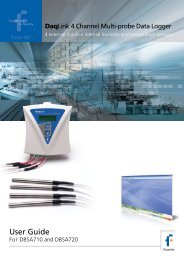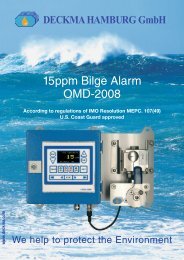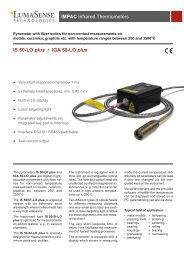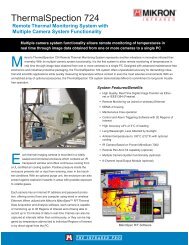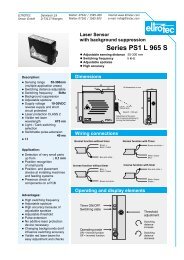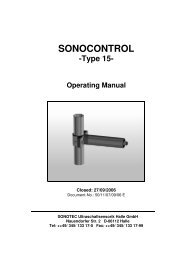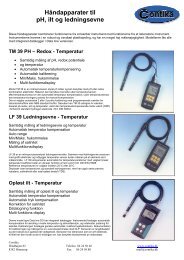Pyrometer- Handbook - Contika
Pyrometer- Handbook - Contika
Pyrometer- Handbook - Contika
You also want an ePaper? Increase the reach of your titles
YUMPU automatically turns print PDFs into web optimized ePapers that Google loves.
10. Fibre Optics <strong>Pyrometer</strong><br />
A fibre optics pyrometer consists of 3 parts: an optical<br />
head, a glass fibre and a signal processing unit. The optical<br />
head contains only the optics and no electronics. In the<br />
converter is the detector and the signal processing unit.<br />
The radiation, coming in through the optical head, is<br />
transported via the lens system into the fibre where it can<br />
be transmitted along for up to 30 metres to the converter.<br />
The glass fibre of the optical fibre is no longer transparent<br />
at higher wavelengths. Consequently, the measurement of<br />
temperatures with glass fibres is limited to 150 °C and<br />
above.<br />
Fibre optics pyrometers have proven themselves in<br />
difficult situations. Splitting the two components has<br />
advantages in these instances:<br />
•High temperatures: The optical head and the fibre have<br />
no electronic components and can easily withstand<br />
temperatures of up to 250 °C. The pyrometer unit itself,<br />
however, is installed at a cooler location and will not be<br />
damaged.<br />
<strong>Pyrometer</strong> <strong>Handbook</strong><br />
function<br />
Illustration 23:<br />
fibre optics<br />
pyrometer<br />
advantages<br />
high ambient<br />
temperatures<br />
41



